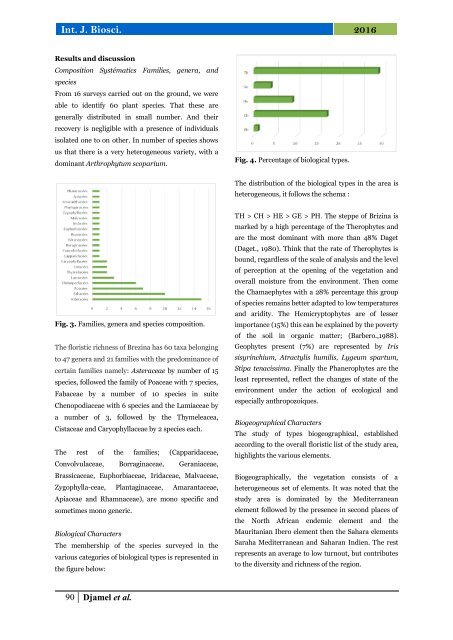Evaluation of plant diversity of the steppe interface, Sahara (Case of Brezina, El-Bayadh Algeria Southwest)
The present work was carried out at the level of the steppe region of Brezina in the Algerian South-west, the objective of this study were the assessment and the description of the state of the ground vegetation based on the plant ecology. Floristic inventory counts more than 60 taxa, divided into 21 families usually returns to the Asteraceae and Fabaceae. The passage of the steppes of Alfa to other formations as sagebrush or Spart (Lygeum spartum) possible show that ecological conditions have really changed. This change is closely related to the pressure enthropozoogenic, translates to the common development of the Therophytiques, spiny or/and toxic and Sahara species. Their dominance remains an explanatory element of this advance of the desert.
The present work was carried out at the level of the steppe region of Brezina in the Algerian South-west, the objective of this study were the assessment and the description of the state of the ground vegetation based on the plant ecology. Floristic inventory counts more than 60 taxa, divided into 21 families usually returns to the Asteraceae and Fabaceae. The passage of the steppes of Alfa to other formations as sagebrush or Spart (Lygeum spartum) possible show that ecological conditions have really changed. This change is closely related to the pressure enthropozoogenic, translates to the common development of the Therophytiques, spiny or/and toxic and Sahara species. Their dominance remains an explanatory element of this advance of the desert.
Create successful ePaper yourself
Turn your PDF publications into a flip-book with our unique Google optimized e-Paper software.
Int. J. Biosci. 2016<br />
Results and discussion<br />
Composition Systématics Families, genera, and<br />
species<br />
From 16 surveys carried out on <strong>the</strong> ground, we were<br />
able to identify 60 <strong>plant</strong> species. That <strong>the</strong>se are<br />
generally distributed in small number. And <strong>the</strong>ir<br />
recovery is negligible with a presence <strong>of</strong> individuals<br />
isolated one to on o<strong>the</strong>r. In number <strong>of</strong> species shows<br />
us that <strong>the</strong>re is a very heterogeneous variety, with a<br />
dominant Arthrophytum scoparium.<br />
Fig. 4. Percentage <strong>of</strong> biological types.<br />
The distribution <strong>of</strong> <strong>the</strong> biological types in <strong>the</strong> area is<br />
heterogeneous, it follows <strong>the</strong> schema :<br />
Fig. 3. Families, genera and species composition.<br />
The floristic richness <strong>of</strong> <strong>Brezina</strong> has 60 taxa belonging<br />
to 47 genera and 21 families with <strong>the</strong> predominance <strong>of</strong><br />
certain families namely: Asteraceae by number <strong>of</strong> 15<br />
species, followed <strong>the</strong> family <strong>of</strong> Poaceae with 7 species,<br />
Fabaceae by a number <strong>of</strong> 10 species in suite<br />
Chenopodiaceae with 6 species and <strong>the</strong> Lamiaceae by<br />
a number <strong>of</strong> 3, followed by <strong>the</strong> Thymeleacea,<br />
Cistaceae and Caryophyllaceae by 2 species each.<br />
The rest <strong>of</strong> <strong>the</strong> families; (Capparidaceae,<br />
Convolvulaceae, Borraginaceae, Geraniaceae,<br />
Brassicaceae, Euphorbiaceae, Iridaceae, Malvaceae,<br />
Zygophylla-ceae, Plantaginaceae, Amarantaceae,<br />
Apiaceae and Rhamnaceae), are mono specific and<br />
sometimes mono generic.<br />
Biological Characters<br />
The membership <strong>of</strong> <strong>the</strong> species surveyed in <strong>the</strong><br />
various categories <strong>of</strong> biological types is represented in<br />
<strong>the</strong> figure below:<br />
TH > CH > HE > GE > PH. The <strong>steppe</strong> <strong>of</strong> Brizina is<br />
marked by a high percentage <strong>of</strong> <strong>the</strong> Therophytes and<br />
are <strong>the</strong> most dominant with more than 48% Daget<br />
(Daget., 1980). Think that <strong>the</strong> rate <strong>of</strong> Therophytes is<br />
bound, regardless <strong>of</strong> <strong>the</strong> scale <strong>of</strong> analysis and <strong>the</strong> level<br />
<strong>of</strong> perception at <strong>the</strong> opening <strong>of</strong> <strong>the</strong> vegetation and<br />
overall moisture from <strong>the</strong> environment. Then come<br />
<strong>the</strong> Chamaephytes with a 28% percentage this group<br />
<strong>of</strong> species remains better adapted to low temperatures<br />
and aridity. The Hemicryptophytes are <strong>of</strong> lesser<br />
importance (15%) this can be explained by <strong>the</strong> poverty<br />
<strong>of</strong> <strong>the</strong> soil in organic matter; (Barbero.,1988).<br />
Geophytes present (7%) are represented by Iris<br />
sisyrinchium, Atractylis humilis, Lygeum spartum,<br />
Stipa tenacissima. Finally <strong>the</strong> Phanerophytes are <strong>the</strong><br />
least represented, reflect <strong>the</strong> changes <strong>of</strong> state <strong>of</strong> <strong>the</strong><br />
environment under <strong>the</strong> action <strong>of</strong> ecological and<br />
especially anthropozoiques.<br />
Biogeographical Characters<br />
The study <strong>of</strong> types biogeographical, established<br />
according to <strong>the</strong> overall floristic list <strong>of</strong> <strong>the</strong> study area,<br />
highlights <strong>the</strong> various elements.<br />
Biogeographically, <strong>the</strong> vegetation consists <strong>of</strong> a<br />
heterogeneous set <strong>of</strong> elements. It was noted that <strong>the</strong><br />
study area is dominated by <strong>the</strong> Mediterranean<br />
element followed by <strong>the</strong> presence in second places <strong>of</strong><br />
<strong>the</strong> North African endemic element and <strong>the</strong><br />
Mauritanian Ibero element <strong>the</strong>n <strong>the</strong> <strong>Sahara</strong> elements<br />
Saraha Mediterranean and <strong>Sahara</strong>n Indien. The rest<br />
represents an average to low turnout, but contributes<br />
to <strong>the</strong> <strong>diversity</strong> and richness <strong>of</strong> <strong>the</strong> region.<br />
90 Djamel et al.


















